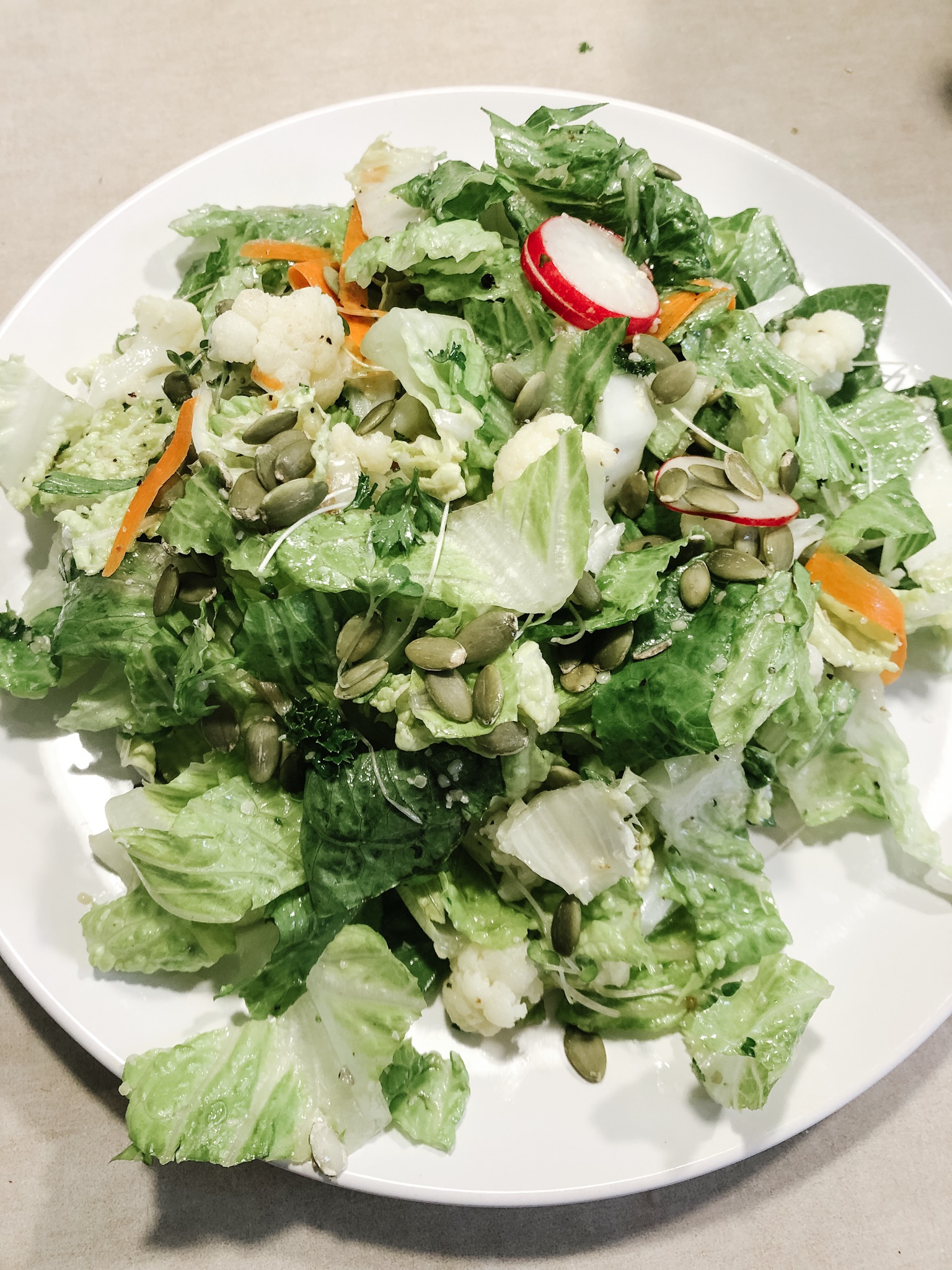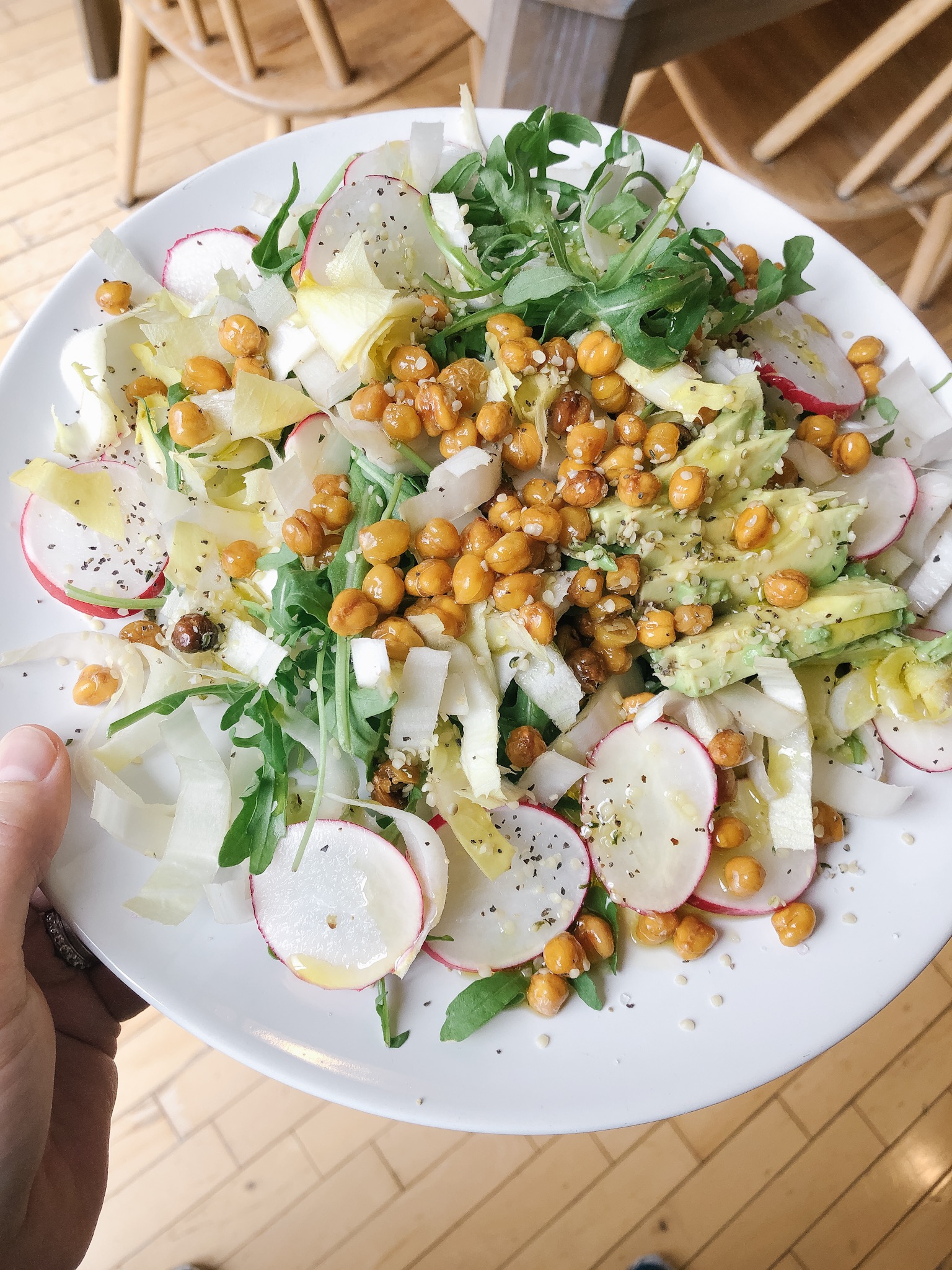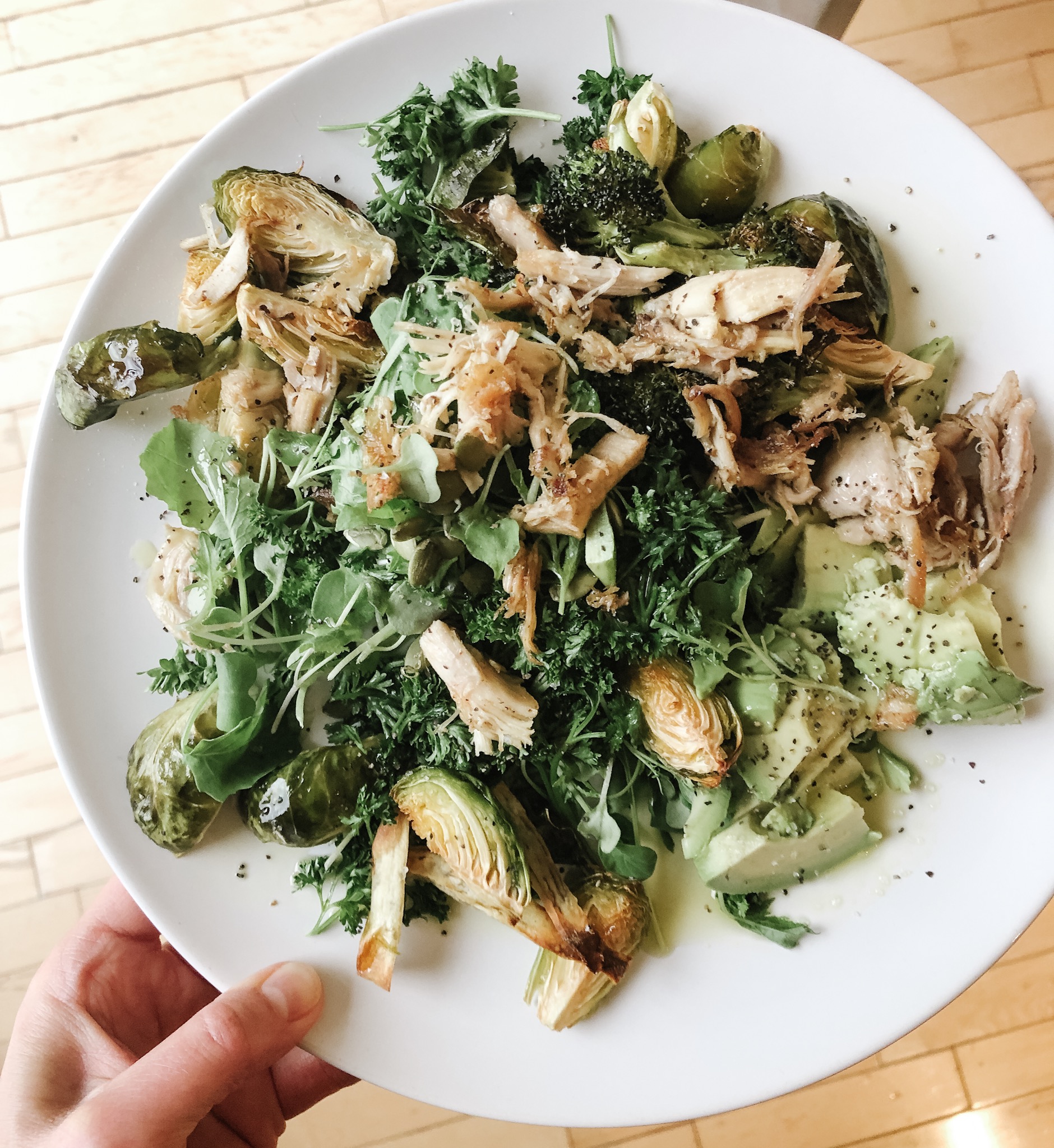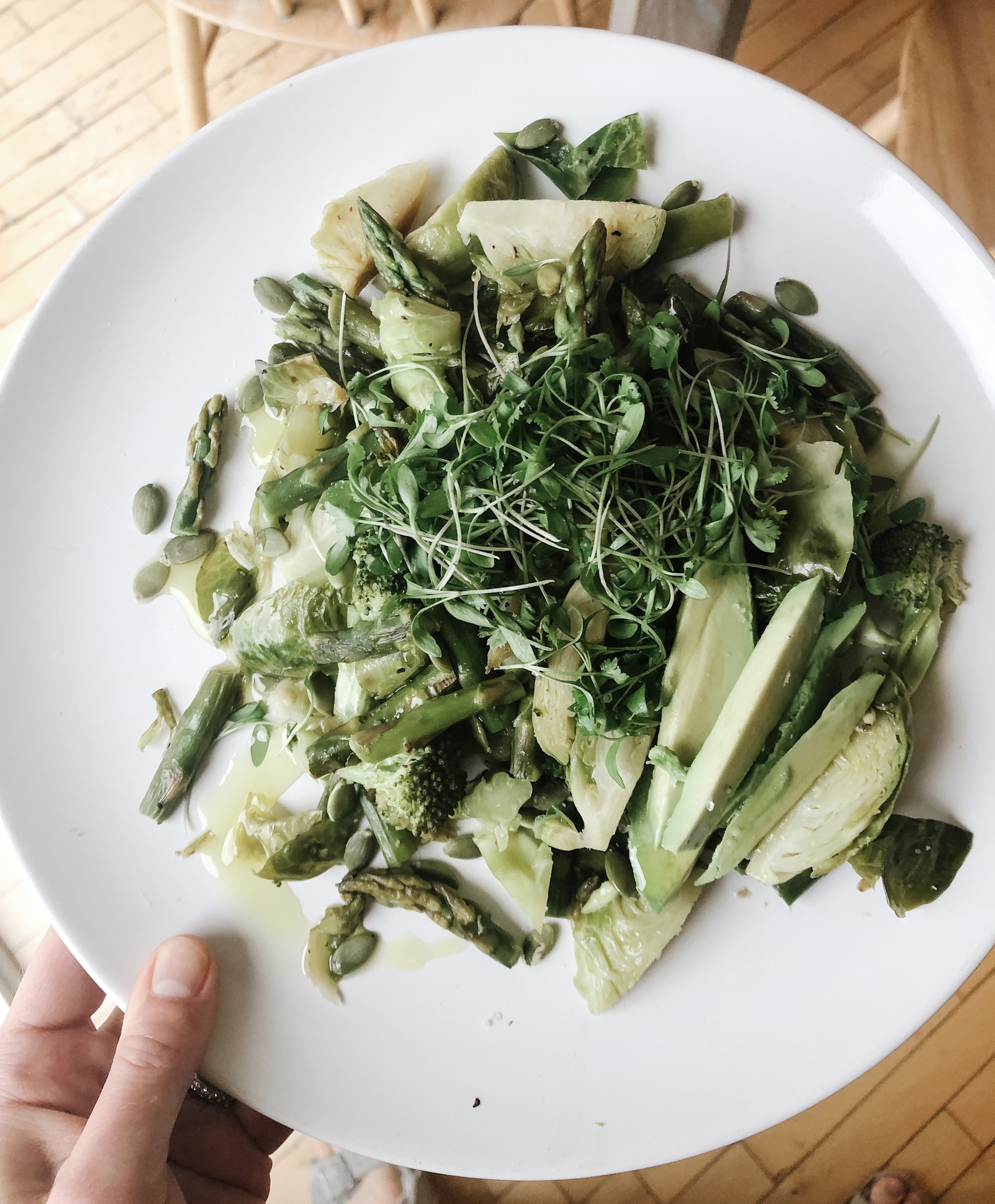How to Build a Healthy + Balanced Salad for Lunch
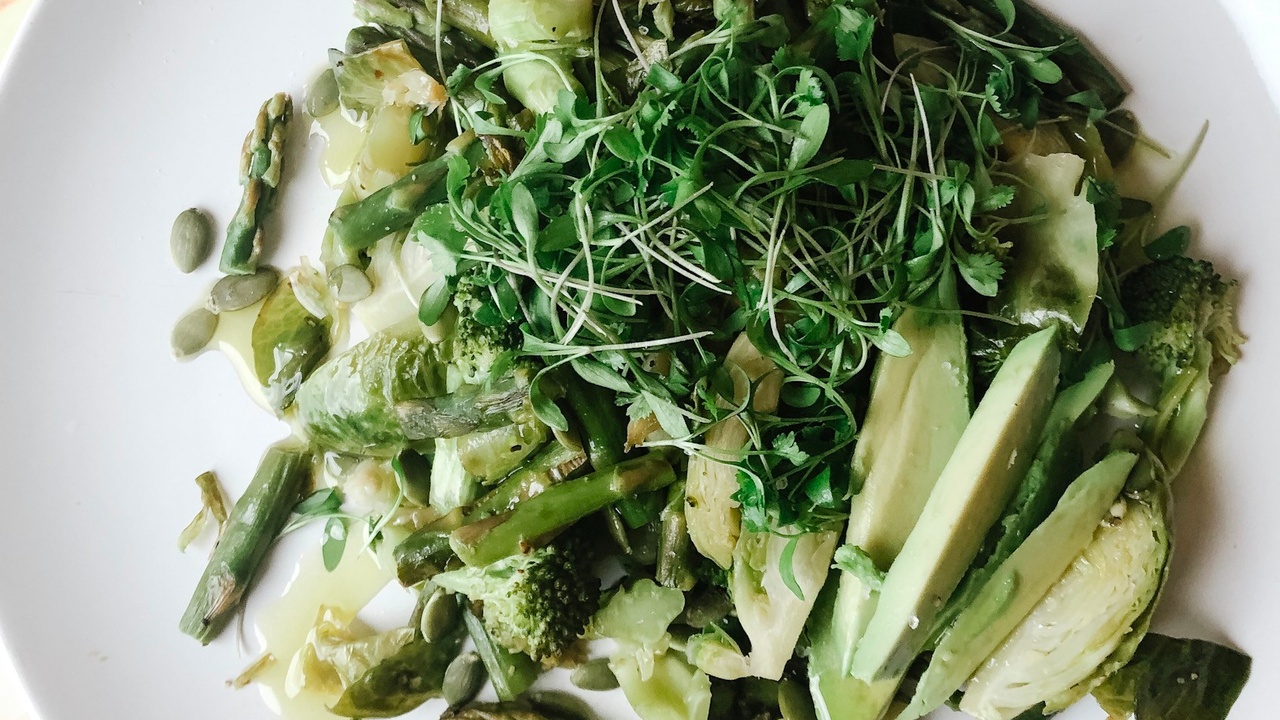
I eat a salad pretty much everyday for lunch. And when I say a salad, I mean a big colorful one!
So you'll guess than I'm excited to share my best-kept secrets on salad creation!
Making a salad appears simple enough but do you really know how to build a nutritious and balanced one that will keep you satiated all afternoon?
I sure do! Keep on reading for all my tips.
The proportions
As a rule, here's the golden formula for a balanced and satiating salad:
- 1 cup of organic greens
- 1 cup of organic vegetables
- 1/2 to 1 cup of protein
- 1/2 to 1 cup of root vegetables*
- 1-3 tablespoons of healthy fat**
- Spices
*If you are looking to loose weight, you could omit the root vegetables completely but if you're looking to gain weight, you could add 1 full cup. For maintenance goals, you can stay in the middle with 1/2 cup.
**For weight loss goals, stick closer to 1-2 healthy fats while those looking to gain weight can go up to 3.
Now let's dive deeper into what each of those categories include and how to pick the most nutritious ingredients.
Your Greens
I could eat greens all day long. It's honestly what my body craves. Some friends call me a rabbit and I can't disagree with them!
The key to keeping things interesting here is to change it up daily. If greens for you only means a mesclun salad, things are going to get boring pretty quickly.
Your greens will make the base of your salad. You want a generous cup (or two).
Ideally, pick organic vegetables so they have a low amount of pesticides and toxins. If that's an issue with your budget, no worries. Follow EWG's clean 15 list (meaning these 15 produces contain the least amount of pesticides and can be purchased non organic).
Here are some of my favorites greens on rotation:
- Romaine salad
- Arugula
- Spinach
- Endives
- Bok choy
- Mesclun
- Napa Cabbage
- Chard
Your Vegetables
This is where you can have fun and bring color and taste to your salad. Try to include 2-3 different options to make up a generous cup.
Get creative and pull from this list:
- Celery
- Radish
- Cucumber
- Asparagus
- Brussel sprouts
- Broccoli
- Cauliflower
- Green Beans
If you're ok with eating vegetables from the nightshade family, you can also consider adding tomatoes, peppers and eggplants.
Don't skip vegetables and only do greens. The combination will offer a wider range of vitamins, minerals and phytonutrients while also providing important amounts of fiber to ensure you feel satiated.
Your Protein
Proteins are essential to the body, no doubt about it. However, I've come to learn that we don't need as much as the recent Keto and Paleo trends seem to present it.
Animal Protein
First off, it's important to not overdo the animal protein. While they offer a vast array of undeniable benefits, they can also raise inflammation (especially red meat and pork), making it harder on the body to heal.
Also note that cold cuts are processed meat and therefore not ideal. It's best to avoid them if you can.
When picking an animal protein, be sure to consider how they were raised. Industrial meats should be avoided at all cost. Here are a few hints when picking your meat:
- Pasture-raised chicken and eggs* (ideally not vegetarian fed as it means they're given corn - often GMO. Try finding a local farmer that let's them roam free and eat worms!)
- Pasture-raised turkey
- Grass-fed, grass-finished beef (ideally try to find a local farmer)
- Pasture-raised pork
*Note that eggs are in the 8 most common allergens for food sensitivities. It's best not to consume daily if you suspect a possible allergy/intolerance.
I like to have a plant-based or fish protein with my lunch and keep the animal protein for dinner but the opposite would be great too. It's best not to have animal protein with each meal.
Fish
For fish options, it's important to prioritize a smaller fish to reduce mercury content. Always go for wild-caught.
This FDA Fish Consumption Advice Chart can be helpful in picking what to consume on a weekly basis:

Plant-based
For plant-based proteins, I like the following, organic as much as possible:
- Hemp hearts (my fave on a salad!)
- Broccoli sprouts (yes, these are a great source of protein and antioxidant powerhouses!)
- Soaked and grilled chickpeas (I like the crunch!)
- Sprouted tofu (once a week max, I like it grilled in the oven)
- Tempeh (note that this is fermented, if you're suspecting candida/yeast overgrowth, it's best to skip it)
- Soaked lentils & beans (pressure-cooked is best to reduce lectin content)
Remember that you can use more than one and get creative!
Your Root Vegetables
These are the feel-good vegetables with a higher carb content. They are more satisfying but should be used sparingly depending on your weight goals. As mentioned above, you can omit them for weight loss goals and do a full cup for weight gain goals.
Reach for these hearty root vegetables:
- Yams
- Carrots
- Beets
- Sweet potatoes
- Potatoes in general (without the skin to reduce lectins. Avoid potatoes if you're sensitive to nightshade)
- Plantains
- Squashes
- Parsnips
- Plantains
Your Healthy Fats
Your eyes, brain and neurological system thrive on healthy fats. It's important to include 1-3 tablespoon with each meal.
You can safely go with these options:
- Extra Virgin Cold-pressed Olive Oil (in dark bottle to avoid oxidation)
- 1/2 avocado
- Organic Extra Virgin Coconut Oil
- Olives
- Pumpkin and sunflower seeds
- Raw nuts*
- Grass-fed Ghee
*Nuts are often an allergen so keep it to once a day and max 1/4 cup.
The Final Touch: Spices
Spices are the secret to a tasty salad that will make you crave it again and again.
I like to use fresh herbs whenever possible and I can never get enough Himalayan sea salt.
Wake up your taste buds with these:
- Sea salt
- Pepper
- Parsley
- Chives
- Basil
- Cilantro
- Oregano
What about dressing?
Salad dressing is where the damage can happen and that's where most people go wrong.
The dressing should not overpower the wonderful ingredients of your salad but rather complement it.
Steer clear of any store-bought dressings...even the ones that look healthy. Most often than not, they contain canola and seed oils as well as preservatives that will undo the benefits of your salad.
Simple is best! I live to simply drizzle Extra-Virgin Olive oil and squeeze half a lemon or lime. With the spices, it's perfectly balanced and just like nature intended.
If you don't suffer for candida or yeast overgrowth, you could also use some apple cider vinegar or balsamic vinegar instead of the lemon.
You could also add a dash of Dijon mustard if you're wanting something more tangy and a drop of maple syrup to balance it off.
Again: keep it simple!
What if you feel bloated after eating your salad?
First, let me reassure you. A salad is literally the food that takes the longest to digest - it can take more than 3h!
If you know you have bloating issues here are some tips to consider:
- Take a digestive enzyme 15 minutes before eating, it will help break down the food.
- Have a few sips of warm ginger tea with your meal; it will warm up the stomach and aid digestion.
- Don't eat a raw salad, simply cook your greens and vegetables. That alone will facilitate digestion.
- Keep your ingredient list simple. If you're trying to identify what causes you bloating, aim to have 4 different ingredients max. Keep the same ones for 3 days and have them daily. If there's no bloating, you know those 4 are in your safe list. Add one more for the next 3 days and so on and so forth. If you don't have the patience for this, the next point is for you.
- Do a food sensitivity test to identify the culprit(s). That way you know what causes inflammation and what to eliminate while you heal and seal your gut.
- You might have gut dysbiosis (meaning more of the bad gut bacteria have been growing). You could do a targeted lab test (my favorite) and consider doing a Candida Bacterial Overgrowth protocol (12-weeks).
- Consider getting guidance and support from a certified health coach to help you get to the root cause. Book your free 20-minute discovery call with me here.
Voilà! Here are my top tips and secrets to a delicious salad that you'll now start craving everyday.
Bon appétit!
Vanessa xo

